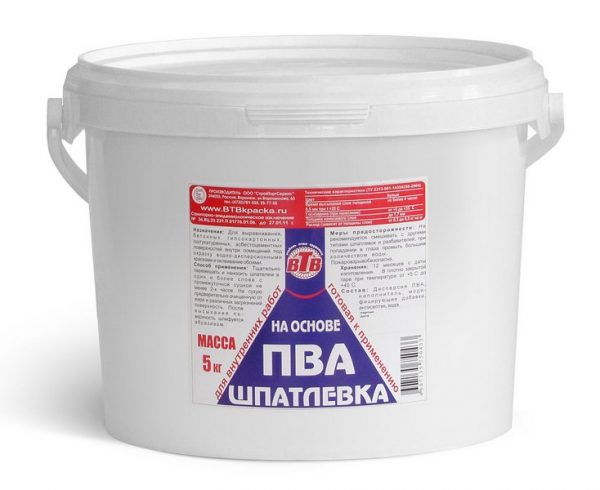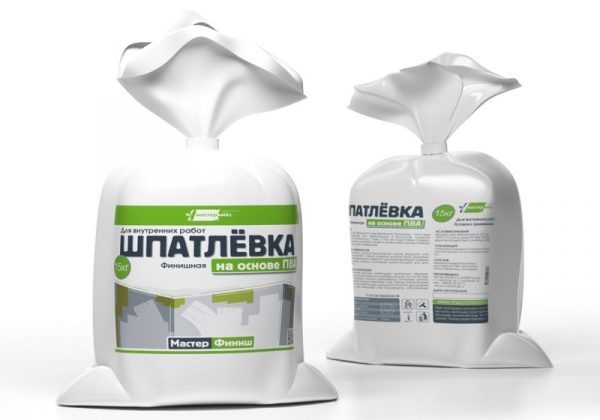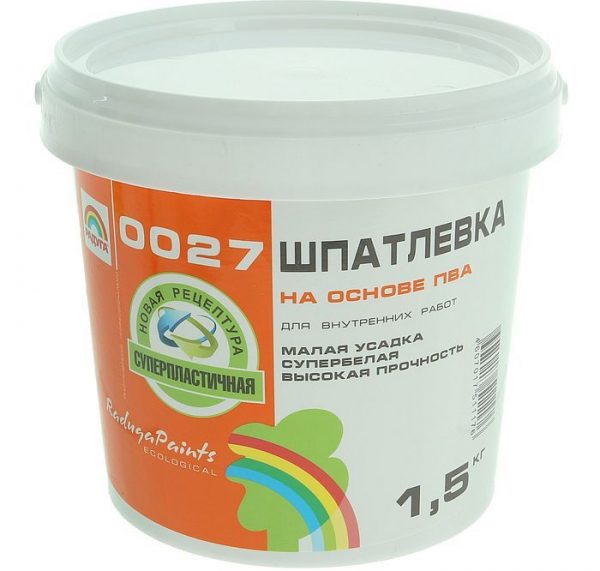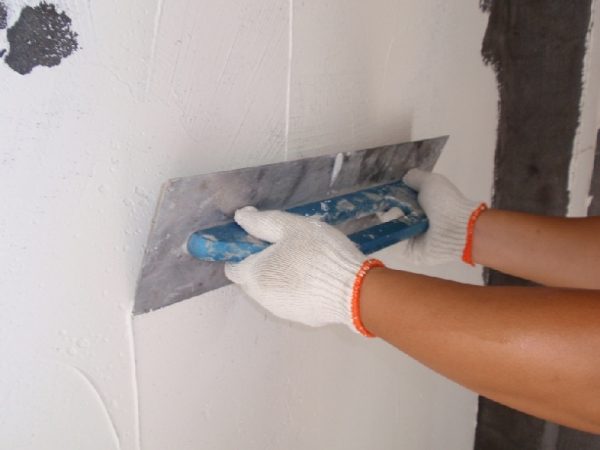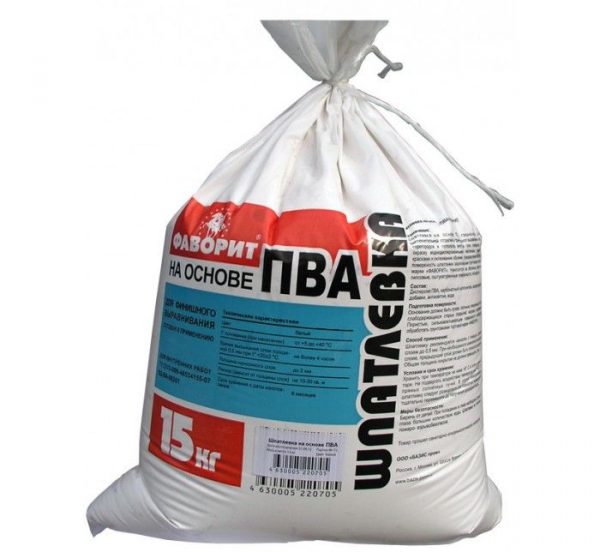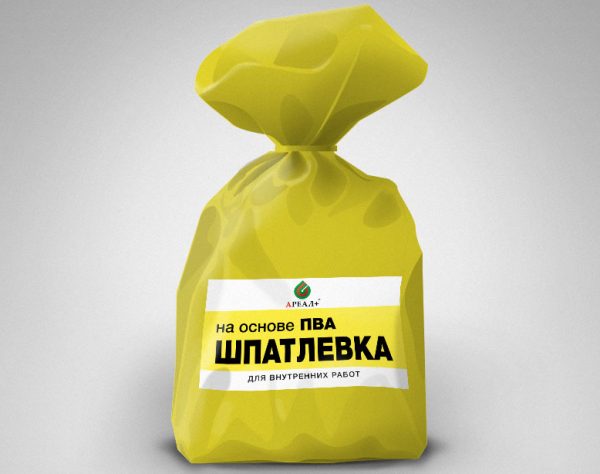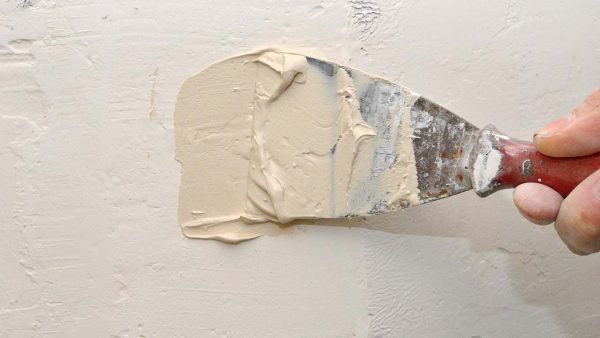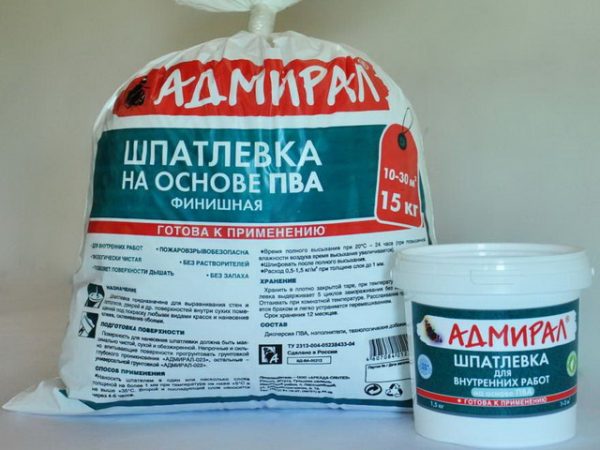In the market of finishing materials there are a huge number of different putties, plasters and building mixtures. Filling on the basis of PVA is ideal for interior work, has excellent technical characteristics, while it is quite cheap. If desired, you can make such a tool even with your own hands.
- Features of putty based on PVA
- Composition and specifications
- Purpose and scope
- Advantages and disadvantages
- The choice of putty for walls
- Putty Manufacturers
- Cork-s
- "Area +"
- "Diola"
- Self-made material
- Mode of application
- Foundation preparation
- Putty application
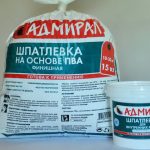
Features of putty based on PVA
PVA putty is made according to GOST 520-20 from 2003. This product is based on polyvinyl acetate, which acts as a binder and is part of the adhesive of the same name. PVA is environmentally friendly and provides a high degree of adhesion with different bases. Since polyvinyl acetate is easily diluted with water and suitable for many construction works, putty is considered universal and multifunctional.
to contents ↑Composition and specifications
In addition to PVA, putty also includes other components. Chalk is used as a filler, and some manufacturers also add talc to the product, since it has the smallest fraction and helps to give the mass evenness without bubbles and potholes. Other components of the putty are:
- carboxymethyl cellulose (CMC) and other plasticizers - to increase softness, reduce the effort to grind treated surfaces;
- latex - to prevent cracking of the putty layer after drying and during the entire period of operation;
- antiseptics and special additives - to protect surfaces from fungus, mold, prevent insect colonization;
- drying oil - to give the solution elasticity and with a view to more convenient application;
- emulsifiers and preservatives - to prevent damage to the composition, increase shelf life.
Usually PVA putty is sold in finished form, since only in diluted form does it meet the requirements of GOST, and with independent dilution it can acquire other technical parameters. Dry mixes based on PVA are often sold in large quantities and are used in industry.
Product features are as follows:
- high bonding strength (up to 450 N / m);
- guaranteed adhesion to basic building materials;
- lack of shrinkage, detachment, cracking;
- ensuring a smooth surface;
- ease of application;
- non-toxicity, complete safety for humans;
- high speed of drying - up to a day.
Purpose and scope
Typically, PVA putty is used for the finishing of concrete, brick, wood, foam blocks, cinder blocks and other popular building materials. The product is suitable for the treatment of previously plastered substrates or walls covered with a base mortar. After puttying with a PVA-based product on the surface, you can apply:
- water-based paint;
- latex paint;
- lime whitewash;
- oil paints and emulsions;
- adhesive compositions.
to contents ↑PVA putty is considered the most suitable for indoor use in rooms with low and medium humidity.It is not suitable for bathrooms, kitchens and other rooms where the humidity level is too high.
Advantages and disadvantages
The product has many advantages, therefore it is very popular among professionals and beginners in the repair work. The material is distinguished by its natural composition, which includes natural components and harmless synthetic additives. During drying and during operation, putty does not emit odors, so it can be used even in children's rooms, kindergartens and hospitals.
After puttying, the walls will show resistance to the development of the fungus, the settlement of microorganisms. As the putty is applied, the surface becomes snow-white, neutral in tone to any type of subsequent finish - it can be painted even with the lightest colors. Other advantages of PVA-based material:
- low consumption (up to 0.5-1 kg / square meter);
- low price;
- evenness, perfect smoothness of the dried layer;
- simplicity in work and fast drying;
- resistance to temperature fluctuations;
- long shelf life;
- strength and non-shrink.
to contents ↑Cons of putty from PVA is also there. It is highly hygroscopic, because it is categorically not suitable for wet rooms and outdoor work. Also, manufacturers do not recommend applying the material under ceramic tiles and for leveling walls with large differences - for this purpose it is necessary to use more durable compositions based on cement.
The choice of putty for walls
You can buy putty based on PVA in any hardware store. It is sold in different packaging: cans of 0.5 and 3 kg, buckets of 10-15 kg, so you can roughly calculate the expense and buy the right amount of product. Do not take the material that is sold in street kiosks in the cold season - after freezing, the composition becomes inapplicable! Also, when buying, it is important to pay attention to the expiration date: it should be normal. It is better to give preference to a well-known brand, even if the price of the product is higher.
to contents ↑Putty Manufacturers
Among the variety of ready putty mixtures, those released by popular brands and the most popular among masters stand out.
Cork-s
In the market of building mixtures in the Russian Federation, this company occupies a leading position. It produces several lines of various putties, including those based on PVA. You can use such tools both for processing large areas, and for closing cracks, chips, individual defects. PVA putty of this brand is sold in buckets of 3 and 15 kg.
"Area +"
The company produces putties in Russia based on foreign high quality raw materials. PVA mixtures give a perfectly flat surface, have a snow-white color, are distinguished by a complete lack of smell and a high degree of plasticity. They are packaged in cans of 1.5, 3, 15 kg, and are also presented on the market in dry form in industrial packaging.
to contents ↑"Diola"
Another major manufacturer of building mixtures using only high-quality imported raw materials. Putty based on polyvinyl acetate of this brand is used for finishing the ceiling and walls, including before wallpapering and painting.
Self-made material
If desired, the putty mixture can be done independently. All components for it are sold in construction and hardware stores. It will be required:
- PVA (glue) - 1 part;
- chalk (talcum powder, baby powder, sawdust dust, dry gypsum plaster - optional) - 2.5 parts;
- plasticizer (dry wallpaper glue or glycerin, drying oil) - 0.05 parts.
As a plasticizer, some introduce casein glue, liquid or grated laundry soap, but with drying oil the smoothness of the composition is the highest.It is impossible to ignore the addition of this component, otherwise working with putty will be time-consuming. First, the dry components are mixed together, then they are diluted with PVA, after which other liquid ingredients are introduced into the mass.
to contents ↑It is necessary to make sure that homemade putty resembles thick sour cream, since too liquid a product will go unevenly, with influxes. Sawdust is added if the mass is planned to be used for closing cracks, and for the finishing filling of walls it is better to introduce white components.
Mode of application
PVA putty is applied on top of the base plaster. It is not imposed with a thick leveling layer - only gypsum and cement products are suitable for this. It is desirable to carry out work at a temperature of + 20 ... + 30 degrees.
Foundation preparation
The better prepared the wall or ceiling, the less material is consumed and the surface becomes more even. Usually, the bases are leveled with basic plasters, removing all significant defects and differences. Further, the walls are cleaned of dirt, dust and primed. If required, degrease with solvents (usually for substrates that have not been plastered).
to contents ↑The priming of walls and ceilings cannot be ignored - this stage helps to increase adhesion between putty and plaster, and increase the life of the finished coating. The primer is applied with a brush or roller in 2-3 layers. Each subsequent layer is performed only after the previous one has dried.
Putty application
In addition to the actual PVA plaster, polyurethane grout and primer, the following devices will be required for work:
- two spatulas - wide and narrow;
- mounting gun and sealant (if it is necessary to repair deep cracks);
- masking tape;
- polyethylene film.
In work with the finishing plaster, only clean spatulas can be used - even a small piece of dried material will leave streaks, dents on the wall. Before applying putty, they cover the floor, paste over the doors, window openings with masking tape. Deep cracks are expanded, cleaned with the sharp end of the spatula, then sealed with sealant.
The PVA mixture is thoroughly mixed to prevent separation of the components. First, with a narrow spatula, the mass is distributed over a wide one, after which the composition is applied to the surface with sweeping movements. The layer thickness should be up to 0.5-1 mm, not more. After drying (after 2-3 hours), the walls and ceiling are treated with polyurethane grout, and then after 24 hours with a primer. The surface will become completely dry in another day, and then it can be glued to wallpaper or painted according to the user's intention.

